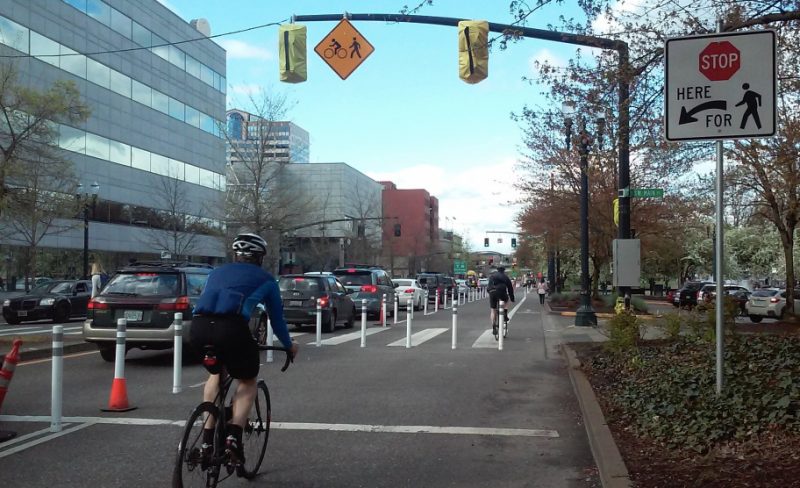
(Photo: Timur Ender)
From now until the end of September, all Portlanders will benefit from a much more humane Naito Parkway. Along a busy section of our marquee riverfront street usually held hostage by speeding motor vehicles spewing toxic fumes into the air we breathe, people will drive more slowly and there will be much more room to walk and bike and roll.
As I type this, transportation bureau crews are installing the plastic wands and other elements that will help re-allocate space on the northbound (east) side of Naito for about 3/4 of a mile between SW Main and NW Couch. The $350,000 project was supported by City Council last October. Former Mayor Charlie Hales was an ardent supporter of improving vehicle access on Naito. Prior to voting on it last fall he said, “Expanding the public realm for bicycles in this city, and is something we’re still committed to.”
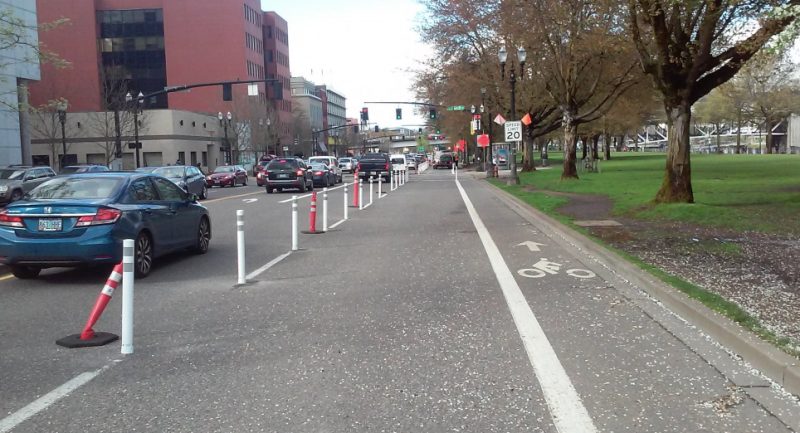
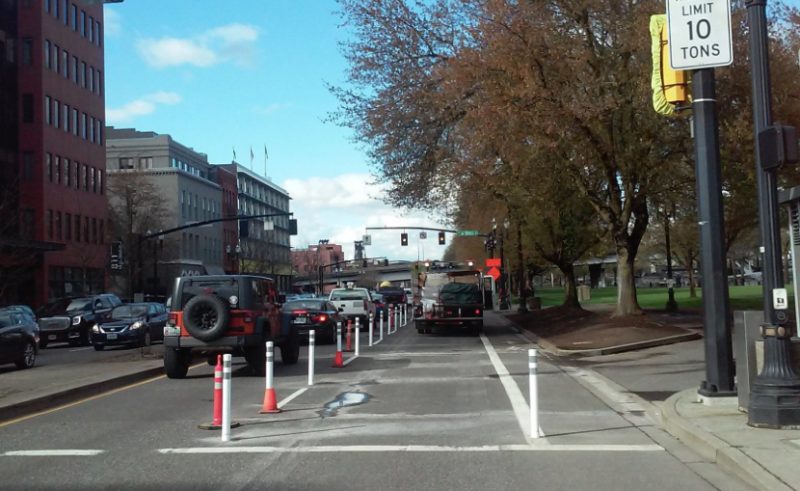
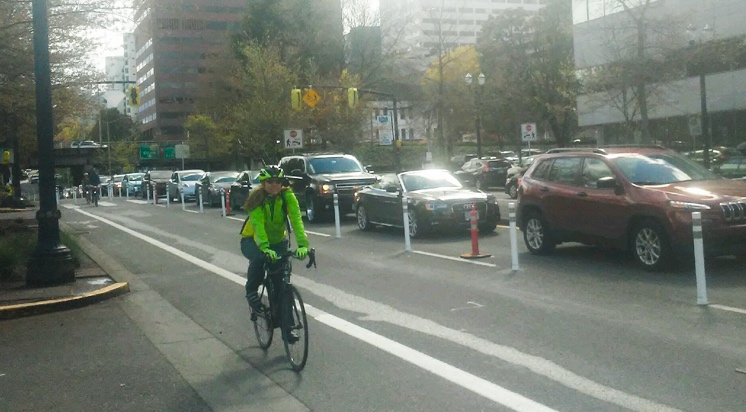
The project represents a significant victory for transportation reform activists led by Better Block PDX. Working with Portland State University students, that all-volunteer group of “tactical urbanists” completed a successful demonstration project in May 2015. That led to another demonstration two months later during Brewfest. Last year the partnership between Better Block, local businesses, waterfront event organizers, PSU and PBOT strengthened and after another three-month trial the City stepped up and decided to make it their own.
On March 31st of this year, area residents and business owners were sent a memo about the 2017 version. Here’s an excerpt that explains what we can expect between now and the end of September:
“… PBOT will install removable white plastic posts to delineate one northbound motor vehicle lane on SW Naito Parkway, converting it to open space for the public to walk and bike and roll safely to Waterfront Park’s festivals and community events. The posts will be installed between SW Main and NW Couch. Better Naito will run from April 28th to September 30th in 2017. In October, the posts will be removed and stored for use next summer.
Advertisement
In related efforts, PBOT will implement a passenger drop off zone on SW Taylor St. just off of Naito to better accommodate people being dropped off for Waterfront events by personal vehicles, taxis, etc. We will also install a new pedestrian signal at SW Naito and Main to improve the safety of that crossing. PBOT will update the traffic signal at NW Naito and Davis to reduce conflicts at the Steel Bridge ramp, installing a right turn signal and bike signal. PBOT will also install white plastic posts to the north of the Better Naito installation between NW Davis and NW Ironside Terrace to better delineate the existing bike lanes.”
Here’s the map of what’s planned:
Given PBOT’s track record with plastic delineator posts (they have an embarrassing history of being uprooted and destroyed by careless or incompetent or just plain mean drivers), we hope these stay put. At the last place PBOT installed a large amount of these posts — the new protected bike lane on NE 21st over I-84 — it only took a few months before all of them were ripped up and gone.
Assuming things stay in place, many people will celebrate this change — and many are likely to loathe it. Even though traffic analysis done last year showed only minor delays during a short peak period for automobile users (about 1.5 minutes in the morning and between 30 seconds and two minutes in the evening, according to The Oregonian) some people were very vocal with their opposition. With that in mind, PBOT will monitor the street again this year to see how the changes impact traffic.
Beyond the physical changes to the street, Better Naito signifies a giant step for people who want healthier streets in Portland. What started as a DIY, low-budget demonstration by grassroots activists with big ideas, has been fully embraced — and now implemented — by the City of Portland. The next step of course is to permanently redesign Naito so that our waterfront can realize its full potential, a.k.a. “Best Naito”.
It will likely take another week or so for PBOT to finish installing everything. Stay tuned for more coverage once it’s all in. Check BetterNaito.com for more info.
— Jonathan Maus: (503) 706-8804, @jonathan_maus on Twitter and jonathan@bikeportland.org
BikePortland is supported by the community (that means you!). Please become a subscriber or make a donation today.


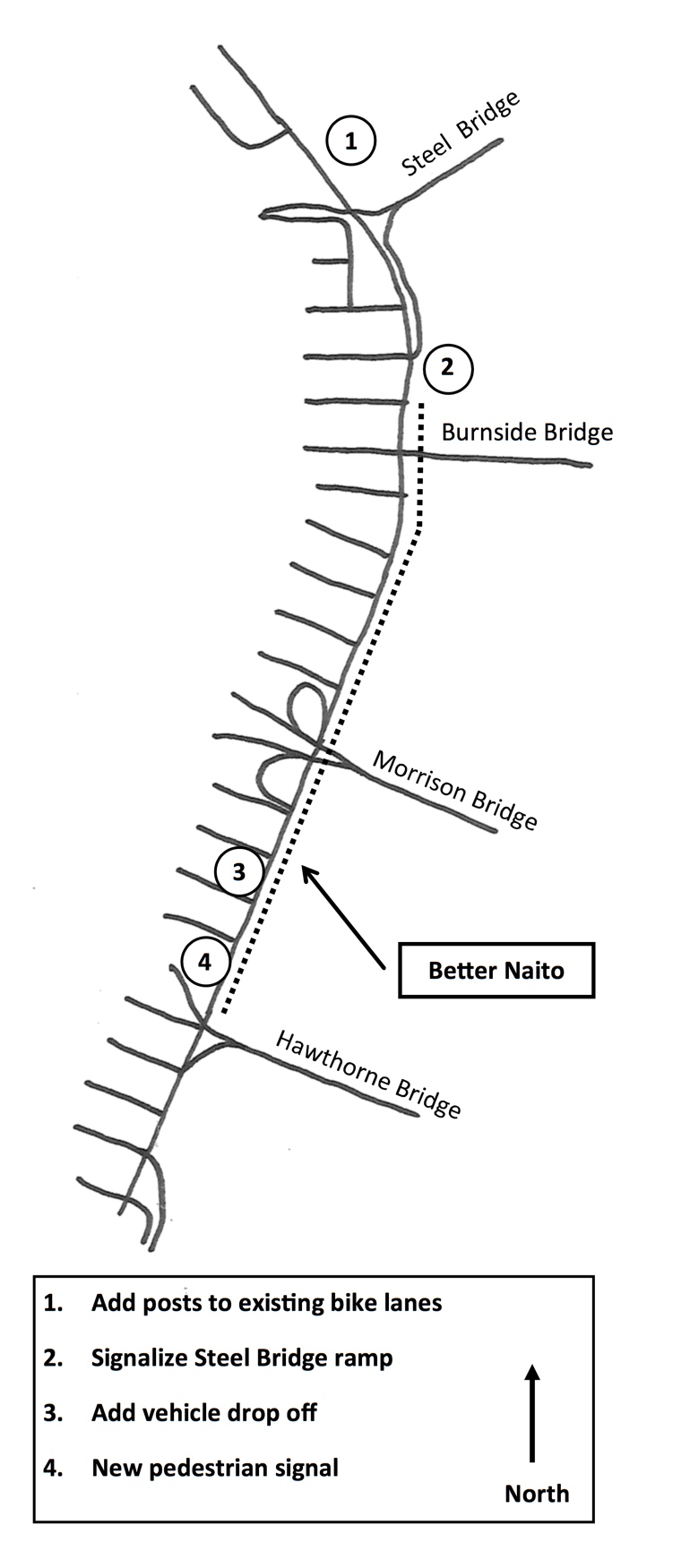


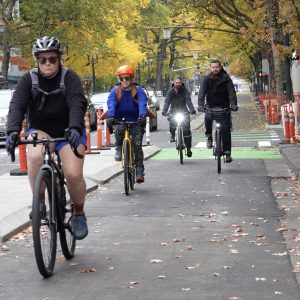
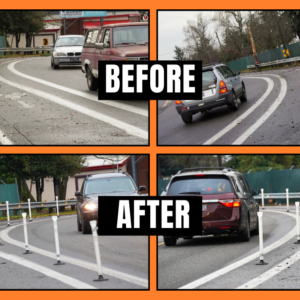
Thanks for reading.
BikePortland has served this community with independent community journalism since 2005. We rely on subscriptions from readers like you to survive. Your financial support is vital in keeping this valuable resource alive and well.
Please subscribe today to strengthen and expand our work.
MacGyver is needed.
Now if we could just get them to relocate those festivals so we could access the park during the summer…
Again, why not Jersey barriers? Plastic tubes and paint don little to protect people from cars.
‘protected’ is a misnomer. This is separated, could even be considered a minimum ‘buffered’ bike lane, but ‘protected’ should be reserved for raised curb at the minimum.
Not according to every design guide published on the subject.
Likely because they’re a pain in the ass to move twice per year and bulky to store. But that’s just a guess. I’m hoping it’s not due to prejudice against The Garden State.
You don’t have to store them. You rent them.
As someone who rides Naito 300 days a year, this just makes it worse. Now you have all kinds of wandering pedestrians, (drunk during summer festivals), cyclists including the tourist Biketown crowd riding the wrong way etc.
I have no idea who you advocate for at times. Certainly not bike commuters!
You won’t print this anyway.
As someone who rides Naito 300 days a year, this just makes it better. Now you have all the cars out of the bike lane.
I have an idea who you advocate for at times. Certainly bike commuters who are sick of drivers making bike commuting a harrowing experience!
You won’t print this anyway.
Yeah, I’m not really a fan of this. It is weird to have people biking contra-flow in the temporary lane, and the looky-loos get in the way of commuters.
The road lane is always a choice and there waiting.
oh cool, you go first!
i will follow right behind, promise
🙂
What many cycle advocates don’t get is that separated two way facilities and protected bike lanes in urban cores are not, will not, be the fastest routes. They are for those not in a hurry, or those with doubts about riding a bike in traffic, not the confident. Think of them as training wheels. Some/most will eventually outgrow them, while others will prefer the slower pace and mixing of users, and eventually those that left them will return when their abilities to cope with auto traffic proximity and mixing diminishes.
Neighborhood greenways are much better suited to long distance, minimal delay bike routes, as are bike lanes on the busier streets.
cycling advocate: someone who wants to see cycling mode share increase and celebrates new bike infrastructure that attracts slow and cautious cyclists.
experienced year-round bike commuter elitist: someone who complains about inconvenient bike infrastructure and slow fair-weather newbies (who lack bicycle driving skills) getting in their way.
Not sure how this will bring in new cyclists. People have to get there somehow, and anyone who can get to this section wouldn’t have trouble with the normal configuration.
To get more people cycling, they need options where they actually are that support actual needs and not simply be a curiosity in an isolated entertainment zone.
Besides, riding Better Naito is harder than most bike riding on greenways, in bike lanes, etc. There is a much greater need for vigilance and adjustment to others.
the impetus for better naito was because the mup along the river is very crowded and/or blocked off due to festivals.
my anecdotal observations suggest that better naito attracts a different demographic from those who are willing to ride in narrow bike lane a few feet away from multiton vehicles going 25-45 mph. this is a good thing.
I understand that the MUP is hopeless. I never ride it even in the winter partly because I don’t consider it as safe as the road, and partly because I prefer a pace that is not MUP appropriate.
Two way traffic plus peds on Better Naito brings everything that’s messed up with the MUP to the bike lane. Even if the peds were removed, it is still a MUP. But at least it would make more sense. Frankly, the fencing on the festivals should be in a little further from the edges to allow more movement.
I’d expect to see a mob of orange bikes with pink boxes out there all summer. And I support this.
I think that there’s a general failure here to recognize that speed does actually matter.
The average person lives 7 miles from work — meaning a lot of people live further away. This means a modest commute at a slow pace could easily be an hour or more each way by the time you factor in lights, signs, etc. That kind of distance is miserably slow on transit which is crowded and unreliable to boot. So it makes sense to drive.
Everyone needs a reason to ride. In my case, I do it for fun, exercise, and efficiency. If I went at the pace a lot of recreational riders go, it would add 1/2 hour each way. That’s not fun or exercise and I lose tons of time. Transit is more than an hour each way not including the wait (or the fact that it’s unreliable). Any trip over a few miles suddenly becomes impractical — especially since I have an hour less each day before I walk out the door.
So I would drive and use the recovered time to work out. I doubt I’m the only one who would think like this.
Funny, I thought average was somewhere in the middle and tell us nothing about the other parts of the curve.
What are the quartile distances?
Personally, I think cycling needs to be focused on transportation rather than recreation…
Almost everyone at some point in their lives in America has recreated on bicycles.
The Waterfront in Portland has about 5 or 6 miles of MUP.
People who commute pretty much use just Naito.
Can’t we just have that and not the share our little lane with waterfront tourist crowd?
Yes, and in this case, the Better Naito replaces a fast northbound route for cyclists that I use every day I commute. Not a big deal because I can usually just ride next to the seawall, but still less good than what we had before. Don’t know why we can’t have a separate cycling path in the park like they have in Vancouver BC…
They can and are good things for bicycle commuters, when done right. PBOT should ask the City of Tulsa for a complete redesign of the Portland waterfront. Tulsa got it right with the Riverparks cycleways. Portland keeps sticking to this MUP end all be all concept that’s fundamentally broken instead of clearly marking lanes and installing a separate sidewalk like Midwestern cities that got to avoid making that mistake in the first place. Sometimes, I wonder if Portland is just serving as a warning beacon of how to screw up a good thing.
But just think of the potential. They could install wands along the sections of roads where there are already bike lanes all over the town allowing peds and cyclists to travel however they like separated from cars. Just think of the roads they could improved this way — Interstate, Lombard, Barbur — the possibilities are endless.
In the bad ol’ days, separated areas for peds were known as sidewalks. Few cyclists rode there because it was illegal, dangerous, and stuрid. But for some reason, if you mark the edge of these areas with plastic wands, it suddenly becomes a great idea.
So double down on what makes Portland’s MUPs awful and unable to scale with growth? Modal separation is a good thing between pedestrian and vehicular modes. Not everything needs to be a living street or a plaza free for all. Pedestrians should have a space where they’re not going to get mowed down, cyclists should have a space where they can move faster than walking speed. Want good infrastructure? Push for cycleways with sidewalks, and keep the multiuse plaza free-for-alls limited to features like Salmon Street Springs and the Ankeney Arcade, etc.
I’m assuming you don’t feel too bad for the cars that are delayed up to 2 minutes by this change, or similar traffic impacts from other projects. While my personal usage of Naito, and thus my personal preference, is similar to yours, it’s quite hypocritical to bemoan that I’ll have to slow down a bit on a 3/4 mile stretch of buffered multi-use path.
Actually I do — I see no reason to slow anyone down needlessly. Driving suсks enough in this town without measures that needlessly worsen the situation.
One thing that I think holds cycling back is that too much of what passes for cycling advocacy disregards or even seeks to undermine needs associated with vehicles. It should be about getting everyone where they’re going. If we treat driving as legit and respect their needs, we’ll get a lot more of the same in return.
Relegating cyclists to low speed paths with peds reinforces the notion that bikes are toys and cyclists don’t belong on the road. This constant focus on improving a very easy core that already has good infrastructure that services a small group perpetuates fear among cyclists and lack of respect for those who ride.
Every place I’ve lived, I’ve gotten people of all ages and levels of ability riding in conditions way more challenging than typically discussed here.
Only in Portland have I had any trouble. The fearmongering, encouraging willfull incompetence, and victim mentality makes riding a bike some kind of “thing” that keeps cycling much more restricted than it would otherwise be and holds us all back.
It’s not needless. People cycling and walking need a safe space to do so during festival season.
So move, or even end, the festivals. Rose Festival especially has been a money-losing venture for the city for nearly two decades now. It’s time has come and gone, and it’s now a time of year people both local and tourists actively avoid Portland just so they don’t have to deal with the mess.
The economy of the situation suggests that the public right of way is becoming a resource stressed by increasing and diverse demand. Fact of the matter is that motor cars cruising through the area doesn’t do much for economic development. The festivals, replete with drunks staggering along a goat path, are cash cows. The goal is to have folks come and empty their wallets.
And just think, if enough of them do, we could find a way to finance a floating bikeway.
Naito should have never been two lanes in the first place. This simply returns it to the proper state it should be for the summer. One lane only.
You also never address the incredibly bad access to get on Naito from the south which the city does nothing about and could do with the money they spend on this tourist move that you endorse.
Something that might concern a lot of commuters.
Awesome. Now just don’t remove them at the end of the summer.
Also:
This is because we build our cycleway “protection” specifically to be easily knocked over by cars, so as to not damage people’s vehicles. The fact that they are all ripped out so easily is by design. It’s time we start caring more about the safety of people cycling than people’s cars getting damaged by smashing into barriers because they weren’t paying attention.
They will be long gone by September.
You’re probably right. They need to be metal posts anchored in concrete. Or better yet, make it a raised cycleway.
Sand-filled barriers or barrels would do well (even with 8-10ft gaps between them). I’m sure (car) traffic engineers will now say something about “shy distance” and/or “end treatment” to which I say “sand-filled barrier is its own end treatment” and “what do I have to do to get 2 feet of shy distance?”.
These are anchored differently. The anchor is a steel sleeve secured into a drilled hole in the street. These delineators attach into that sleeve and are not surface mounted using bolts into asphalt. They should last longer. Also, since they are part of a linear installation, like on the Hawthorne viaduct, they are less likely to be driven over.
People who like this project should just ride the waterfront the rest of the year as it is less crowded, safer, and more insulated from cars than Better Naito.
Why putting counterflow traffic and peds together is a good idea without a compelling reason is beyond me.
I do ride the waterfront path the rest of the year. I prefer that over the door-zone lanes on Naito.
I dislike the lanes going south, but going north there are no doors to worry about.
We need to move the carnival to the park blocks by the Museum. Make the dropoff for taxis and private auto peds on Monrow on the west side of the Museum.
Better yet, stick it on the south waterfront. Tons of transit and active options in, by the river, and mostly out of the way of things.
Some elements of this project could do more harm than good, specifically adding a signal at Main Street. The current signal timing is awful for cyclists and pedestrians waiting to cross east west. The existing crosswalk at Main allows us to cross quickly and safely. Unless the new signal is programmed to quickly turn red (which could have been accomplished by a rapid flash beacon much less expensively), the new signal could significantly delay crossings. I’ve seen plenty of people dash across Naito at Salmon because the signal timing for crossings is so long. Let’s hope PBOT is smart enough to install a rapid response signal at Main.
They’ll last about as long as the ‘barriers’ coming off the Broadway Bridge onto Lovejoy did… What a waste of money. Make them out of something cars will be sorry they ran into.
I do love Better Naito but agree that accessing it by bike from the south is a challenge. If you leave from PSU and want to take the Steel Bridge, Naito is a good option–except for getting from campus to Naito and then the waterfront to Naito. I’m comfortable enough in traffic but there should be better biking infrastructure without going all the way down the South Park blocks.
I agree. Finding a safe way to bike from Lair Hill, Barbur, or Terwilliger to Waterfront Park is really difficult. Better Naito is ok I guess, but it should really extend past the Hawthorne Bridge to at least Harrison Street.
Remember, one step at a time.
Please. That is a baby step he’s asking for.
Why not a paved MUP along the western edge of Waterfront Park? Keep the bike lane (with some improved separation) on Naito for faster cyclists and let peds & slower bikes use the MUP. That would be a permanent fix. Yes, it would narrow the part of the park that could be used for events, but only by 15 feet, more or less.
$3.5 million reasons.
Sounds okay to me. ANYTHING that makes it more difficult, expensive and time consuming to drive has my vote even if it’s less than ideal.
The disincentive to drive should be that the alternatives are better, not that driving suсks more than the alternatives.
I ride this section every working day. Except in bad weather when no one is out, configuration slows me down than it does cars while making it less safe to boot. The vehicles are not a hazard on regular Naito. Between Hawthorne and Steel Bridge, there aren’t any hook or cross opportunities at all on the river side. The bike path is good and visibility is excellent.
Under “Better” Naito, cyclists and peds meander about like stray chickens creating oncoming hazards and making passing difficult. They dart into crosswalks much worse than normal and almost ignore signals completely. The only thing that protects people is that movement is so slow it would be practically impossible to get hurt.
I get that many cyclists don’t like riding Naito. But they have alternatives literally within stone’s throw.
For all the talk here about how bikes need to be separated from cars, why are people so supportive of mixing bikes and peds? It’s unsafe except at really slow speeds and for cycling to be a viable form of transport, people need to be able to ride at speeds that aren’t just an alternative to walking.
“The disincentive to drive should be that the alternatives are better, not that driving suсks more than the alternatives.”
I know what you mean here, but really, “driving sucks more” is logically equivalent to “alternatives are better”. Even in this instance, making the alternatives “better” (depending on how you view it) comes at the expense of making driving “suck” roughly two minutes more. With the limited space available in downtown areas, it’s quite a trick to keep the joy of driving at a constant level while simultaneously making biking/walking/transit “better”.
Most people drive now—even with the suckiness of congestion and parking hassles—because “the alternatives suck more”.
The way I like to think of it is maximizing the total amount of joy and minimizing the total amount of suckiness. In an ideal world, joy to one doesn’t bring suckiness to another.
For example, if there were no bike lane on Naito, most cars would drive further right. With the curb right there, the only safe thing for a cyclist to do is ride further left forcing motorists to do an actual pass which makes the right lane less usable for them. In this example, all it takes is a little paint and everyone wins. Everyone’s movement is more predictable. Bikes are safer and cars are faster. Even the bikes are probably faster since they can’t get stuck behind cars stuck behind slower cyclists.
Sometimes, a benefit to one comes as a cost to someone else. When this happens, it’s nice for it to be clear that benefit is larger in magnitude than the cost. Because then it makes sense and is easier to swallow if you’re the one who absorbs the cost.
If the cost of making biking better is to make driving worse, then so be it. But that should be viewed as a cost imposed on people, not a benefit that should be maximized in its own right.
Likewise, we could consider the danger and inconvenience of those who currently bike and walk a cost imposed by our auto-optimized system. Not to mention costs imposed on everyone in the form of pollution (air, water, noise), war, etc. Minimizing that cost seems a worthy goal in its own right.
…should probably have said “…danger and inconvenience for those who currently”…
I agree — except those costs are borne by everyone, and, one could argue, most heavily by drivers themselves. In Portland, urban air pollution is mostly driven by diesel and wood smoke (and, to a certain extent, industrial pollution); cars are a much less a problem.
The goal should be reducing the costs while maintaining the benefits.
You mean like switching from smoking to vaping?
That is exactly what I meant. Or at least smoking filters.
Driving is dangerous to society. I equate making driving harder with any other action to curb danger.
While nobody disagrees driving in Portland sucks, the problem isn’t that it’s a bike versus car problem so much as a bike versus transit problem. Every time a new MAX line opens, the bus service gets cut back further. TriMet’s not usable now. And there’s more bicycle and automobile traffic as a result.
“For all the talk here about how bikes need to be separated from cars, why are people so supportive of mixing bikes and peds? It’s unsafe except at really slow speeds and for cycling to be a viable form of transport, people need to be able to ride at speeds that aren’t just an alternative to walking.”
This I can’t agree with more. If I’m actually trying to get somewhere, rather than out for a meander (which, if I want to meander, why would I do it on a bike?), I’d much rather mix with autos than with peds. At super-slow speeds, sure, bicyclists are not much more than mechanized pedestrians (and again, if I wanted to travel at walking speed, I would walk), but anywhere over about 8-10 mph, I feel I have more in common with the motorized than the ambulatory.
“I’d much rather mix with autos than with peds”
you and the other 2%…
this facility only affects travel in the northbound direction and there is a parallel route two blocks away where faster northbound cyclists can semi-legally mix with traffic.
It’ll only travel in the northbound direction if it gets enforced. Given that there’s zero enforcement for “ride right, pass left” on the existing MUPs in Portland, what are the odds a one-way restriction’s getting enforced on Naito?
the southbound bike lane on naito is unaffected.
Well, this is a preference between two arguably bad choices. It really comes down to one thing: speed.
Until we rearrange everything to create affordable and tolerable living space within 20 minutes’ walking distance of everything people need, there will be a desire to travel faster than walking speed. How can we possibly do that safely? Drivers, when not limited by other traffic, can travel at least 20 mph, and have most “obstructions” signalized and legalized out of their way most of the time. Do we assume that if people have places to go, they will just drive a car, and if they are on a bike, they must not have anywhere to really be, and won’t mind traveling at walking speed? Why, as a bicyclist, should I only have a choice between going 20 mph or going 4 mph?
I don’t think the 98% necessarily prefer to ride through crowds of pedestrians, they just don’t, under any circumstances, want to be anywhere near “cars”—and wobbling around pedestrians is the only alternative ever provided. Why do we outlaw riding on sidewalks, but then expect bicyclists to share essentially a sidewalk with pedestrians in spaces like this? Why is it only “semi-legal” for me to use an alternate route to go faster than 4 mph? If we gave bicyclists the same treatment we afford drivers—a relatively clear path, with only traffic of a similar nature (i.e., other bicycles), moving at speeds of 10-15 mph that was wide enough to overtake safely at more than 4 mph—then we’d have a better choice. I mean, if we’re doing segregated, why only go halfway?
“I don’t think the 98% necessarily prefer to ride through crowds of pedestrians, they just don’t”
there are no crowds of pedestrians on better naito during work day commute hours. methinks that experienced year-round commuters doth protest too much.
You know, “doth protest too much” does not mean the author is complaining too much…
much of the protest about this facility is just as fake, as lady mcbeth’s.
i was wrong about the source but my use was correct:
It is found in Act III, Scene II of Hamlet, where it is spoken by Queen Gertrude, Hamlet’s mother.[a] Gertrude uses the line in response to the insincere overacting of the Player Queen stating her love for her husband.[2][3]
Ok. Certainly there are “peak times”, and there are variations in usage volumes among facilities. Of course I cannot universally complain about instantaneous conditions on any particular facility—but wait until June. I suppose the underlying psychology of my true complaint comes from the expectation that when bicyclists are on the road, they must kowtow to restrictive laws and the bullying of motorists who almost universally expect them to “stay out of the way”. When not on the road, bicyclists are expected (and required by law) to defer and yield to pedestrian traffic—as it should be, BTW—which, in my experience, usually results in travel speeds of about 5 mph when pedestrians are present. Further, I have not yet found a single place or facility where bicyclists can expect to have the homogeneous traffic experience that drivers “enjoy” on the streets and pedestrians have on the sidewalk. As an example, I was just attempting to research how one might get a bike through Washington park these days, and I found the reservoir project pages that describe the various road closures. One segment on Lewis Clark Way is described as “multi-use”, yet requires bicyclists to walk. That’s really single-use: walking. I grow weary of always being seen as the interloper that doesn’t belong anywhere, and therefore viewed as the most easily inconvenienced, if not outright dismissed. Maybe segregated facilities that are expected to be shared with pedestrians, and are usually (not always) too narrow for their intended use, feel too much like cattle chutes to me, and I hate being herded. Maybe I have something to prove by choosing to interlope with “cars” rather than pedestrians. Perhaps the other 98% don’t feel this way, and will be OK with anything that keeps the cars away, at least until the novelty of using a bike wears off.
There, I said it. Thanks, Doc.
During workday they festivals use it as a loading zone during daytime…
I rode it all last summer, I put up with it since it is only a mile or so, and I do slow down.
It still was a bike lane, now it is just added festival space to a city owned park that is rented to private enterprise all summer.
It is no longer fit for bicycles.
I haven’t read any of this discussion as insincere.
I for one am glad to once again have the ability to escape the waterfront phone-glued walkers and loose children, without having to deal with the phone-glued drivers on Naito drifting into the bike space, and having this in a more visable/semi-permanent fashion should help. Biggest problem last year was people driving into the Better Naito space to then park and drop off passengers. Also was a big problem with festival peeps in their golf carts, and during fleet week when sailors were driving in it without any respect for others. Hopefully the Taylor dropoff and having more posts will help with that.
I never had much issue with people walking in the shared space, and I rode it nearly every day last year. Then again, I tend to ride a little slower, and I’m not trying to blast through at a high speed, so having to slow down a touch more and communicate with a group walking in front of me isn’t that big a deal. Thank you, PBOT!
Also, I hope the posts north of Davis are going to be permanent. Filling the Naito gap was great, and I use that route a few times a week, but once again, bad drivers parking in the new bike lane has been a fairly constant problem, so permanent posts would be wonderful!
It has significantly delayed auto traffic on Naito. Perhaps the average drive down Naito has been nominally altered. But, that is not the case during critical rush hours. It has been a standstill the last couple of days at 5:30 p.m. I’m all for a permanent “Better Naito,” but this is horribly executed. (p.s. I appreciate your coverage of it, Jonathan.)
This is one of the things I’ve wondered about. When I ride through, it looks like the cars aren’t moving at all and sometimes zero cars get through on a light cycle. But at other times, traffic is heavy but cars are moving at speeds I can’t match.
That kind of throughput could really drive averages up — particularly since normal Naito rush is pretty slow. Also, my guess is this just has to have an effect on other roads which also get gummed up. Why on earth would someone drive Better Naito unless they absolutely had to?
Anecdotally, my friend who is multi-modal says that Better Naito adds much more than 2 minutes to his rush hour drive. Makes me wonder exactly how they are calculating those numbers.
2 minutes??? The horror!!!
I’m sure it’s an average change in transit times. Some people see no slowdown, others see much longer slowdowns. Rush hour traffic can be funny, the longer transit times might only happen during a few small windows during the day
Naito is already like this without Better Naito. The lineup of cars to get onto the Hawthorne Bridge extends back to Harbor Drive every afternoon. The conversion of one car lane to a cycling one is not making things much worse than they already are.
There is some truth to this. Due to the lane loss at Steel bridge, it eventually goes to one lane anyway. However, traffic opens up considerably once you clear the Morrison Bridge and typically moves right along until a little before Davis — though many cars leaving for Steel helps keep things flowing.
There is some value in having the road being used for car storage as they eventually back up somewhere which has all kinds of weird side effects. I work at OHSU and on a really bad day, the traffic can back up all the way to the hospitals. Yesterday, the traffic on Sam Jackson was backed up all the way to the second curve from the top. I just biked back up and took another way down. Terwilleger was a disaster too, but at least there’s a bike lane on that road.
Evening auto traffic out of downtown is significantly slowed by the current closure of several Morrison Bridge lanes, resulting in slowed traffic on the Hawthorne Bridge, which I have ridden past, and probably the Burnside as well.
I don’t understand why this project was funded (and approved and implemented so quickly). The esplanade already provides a safe (truly protected, not just plastic bollards), slow, mixed-use way to get around just 20 – 50 feet from Naito. Why did we need to spend limited bike infrastructure dollars on creating another slow, mixed-use, but less-safe two-way bike lane directly on Naito? There are huge needs for better (or ANY) bike infrastructure in other parts of the city, in places where there are routine injury or fatality crashes. It’s very frustrating to see projects like this happening while the city and bicycling advocates appear to ignore needs elsewhere in the city. If we want to improve congestion and encourage people to ride, we need to give people safer ways to get to downtown and inner NE/SE from farther out parts of the city.
Hear! Hear! I can think of a number of places I’d rather see some resources — I was thinking about this exact issue while riding along Sandy this week as the alternatives are much longer and slower.
Or for a place that really gets a lot of airplay here, how about Hawthorne? Tons of activism for a single crossing, but really not much about the pretty tough cycling there (though alternatives are better than Sandy).
I prefer riding Naito from the split with Barbur Blvd to downtown instead of staying on Barbur which becomes 4th Ave. I think Barbur and Natio need lower speed limits, better transit, and better land-use planning and road design.
Because the path is not available when there is a festival going on.
The project length is only .75mi
While a lot of attention is needed throughout the city, better naito has the advantage of only requiring less than a mile to make a huge impact. Sandy would need considerably more, Barbur is another street that comes to mind.
Because Portland likes to show off as a great place to walk and ride in the summer, when all the tourists are here …
Don’t expect this to remain clear during the Rose Festival.
Shocked no one is complaining about the lead picture.
The poles look tightly spaced. A novice bicyclist (like a child) cannot navigate those gaps
I suspect they’re that way on purpose. Lots of peds there and maybe the intention is to slow down cyclists coming off “Just Fine Naito” onto “Better Naito.”
People here seem to like posts near paths despite the fact that they’re obvious hazards. What I don’t get is why no one complains that directly adjacent to “Better Naito” is a section of Naito that many cyclists take every day which doesn’t even have a bike lane so you have to take the lane.
As someone who rides this stretch every working day, Ive become kind of ambivalent about it. Northbound the existing setup is one of the less stressful parts of my commute. Southbound the existing setup is a disaster where traffic mixes under the Morrison bridge, and now that the “secret on-ramp” is gone just past the Hawthorne bridge, there’s no good way onto it except waiting for the light at an intersection. I suppose that’s the logic of the weird counter-direction lane. I’ll try it today and see if it makes things any easier, or is just a head-on collision waiting to happen.
Most of the people on this site are brave souls. People who ride whenever you wherever. The people this will attract aren’t probably reading this article in large numbers.
Naito will eventually go to one lane each way. The writing is on the wall. Now we get to see partly what that looks like. Nervous Nelly’s and neds or not.
I don’t think it’s bravery. Long-term abuse can result in internalization of abuse as a psychological coping mechanism ==> Bike Stockholm Syndrome.
That would (or at least should) look totally different. The problem with Better Naito is that it converts a reasonably decent bike and auto lane into a free for all MUP.
One lane in each direction would provide plenty of space for one way bike traffic separated from two way ped traffic.
I see the comments on this thread are carefully manicured to avoid any opinions that differ from that of the editors. Typical Maus echo chamber.
Huh?
I mean, while it is true that Jonathan is a wonderful person, very smart and debonair, I see no evidence that commenters are tailoring their opinions to fit his. But even if that were true, that would be fine because Jonathan really is the most intelligent person in the room. And oh, so handsome!
Why is it so hard to install concrete barriers? They use them all the time on construction projects. Put sand barrels at the ends and call it a day.
They could even put some graphic designed clings along the roadside to dress it up at major intersections. Cohesively advertising the marquee events at the waterfront and (discreet) sponsor logos. Or just paint the thing in a upbeat color block scheme of cheery greens and blues.
PBOT seems intent to never go far enough to make any real progress and yet just far enough to piss off the cagers. I just don’t get it.
Because most people, even inside PBOT, drive. So they say “well, what if I “bump” them and screw up my car?
Seriously.
Bumping people is fine. Bumping your car….not good.
So, that’s really why. It’s not the money because the city blows far more cash on far more pointless things.
Wait… Who thinks “bumping” pedestrians is fine?
Confused people. Fortunately, very few of them drive cars.
Probably because they’re a total waste of money, reduce the ability to adapt to specific circumstances, take loads of space, and are ugly.
If we really need concrete barriers for protection from cars moving at parking lot speeds in an area with no cross streets or hook potential and alternative routes nearby, there is truly no hope for cycling.
For the same money that they make an area temporarily more comfortable for people that don’t ride, they could permanently make another area safer and more rideable.
Given how crowded it gets, it’s better if fair attendees walk that area rather than bike. It’s not like walking the entire length (presuming they even want to go that far) takes significantly longer than riding it.
Jersey Barriers arent a waste of money because any public works department worth their salt has a thousand of them sitting around to be used as needed.
Like everything else, they’re not an inherent waste of money but they are a waste of money if used inappropriately.
Such barriers in this environment for the purpose of protection of cars would be a poster child for advocacy run amok. That anyone who cycles could say with a straight face that these scarce resources wouldn’t be better utilized somewhere else astounds me.
heavy and space taking objects that are only used occasionally are better rented by any small jurisdiction public works department watching every penny.
I couldn’t see this in the map or text, but where will the loading and unloading happen?
(I’m not talking about passenger drop offs)
the vertical delineators unscrew from the bases. (also bendy)